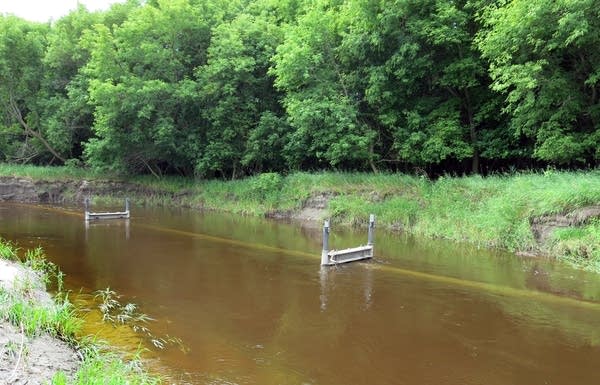Erosion exposes Enbridge oil pipelines near river in NW Minn.

Like many streams in the Red River Valley, the Tamarac River twists and winds its way across the northwest Minnesota landscape.
Constantly changing shape as floodwater erodes the soil, the Tamarac flows into the Red River about two hours north of Moorhead.
But in a grassy swath carved out of trees that flank the river, the channel's normally placid brown water is broken by pipelines spanning the Tamarac.
Flooding has uncovered three of seven Enbridge Corporation pipelines that cross the river, pipes that largely carry crude oil from Canada across Minnesota. Although the pipelines generally are buried three to four feet below ground, in some places erosion has exposed them to the elements.
Create a More Connected Minnesota
MPR News is your trusted resource for the news you need. With your support, MPR News brings accessible, courageous journalism and authentic conversation to everyone - free of paywalls and barriers. Your gift makes a difference.
Pipelines are visible in this image from Google Maps:
Chad Jerome, a local farmer, said he has seen an exposed pipe in the spot for the 14 years that he has planted and harvested fields along the river. But until recently he didn't realize how many pipelines were uncovered.
"I guess I have faith that Enbridge knows what they're doing and that safety measures are in place and it's not an issue," Jerome said.
The three exposed lines include a 24-inch pipe, constructed in the early 1960s, a 34-inch line built about 1968, and a 20-inch pipe laid in 2010, Enbridge spokesperson Becky Haase said the lines flow across Minnesota to Superior, Wis.
Some pipes are suspended across the river channel, which is about 30 feet wide. In one case, a pipe is exposed along the river channel for about 100 feet. Enbridge has installed steel legs to stabilize that pipe.
The exposed pipes run the risk of pipelines being damaged, but no law requires Enbridge to rebury them, said Jon Wolfgram, chief engineer for the Minnesota Office of Pipeline Safety. The agency enforces federal rules for pipelines in the state, which require companies to check exposed pipes for corrosion every three years.
"There are certainly risks," he said. "If you had log jams, and things like that could put a pipeline at risk, yes."
Wolfgram said the risks increase the longer a line is exposed. But determining the level of risk is up to Enbridge, not the Office of Pipeline Safety, he said.
It's unclear how long the pipes have been exposed, but Wolfgram said they were during the only time a state inspector visited the site, in 2007.
Although federal regulations specify how deep pipelines must be buried, Wolfgram said the rules only apply during initial construction.
"If it does become exposed, it more or less becomes a requirement for the operator to monitor that and inspect it," he said. "But there isn't necessarily any requirement making them bury the pipeline again."

Wolfgram said he is aware of several locations across the state where exposed pipelines cross rivers or ditches. Enbridge has detected exposed pipes at a handful of Minnesota river crossings.
Enbridge, which began inspecting exposed pipes at the northwest Minnesota site in 2009, has determined the lines are safe and do not pose any risk said Haase, the company spokesperson. Initially, she said the company conducts risk assessments at the site and did not plan to rebury the pipes.
"We have Enbridge crews out there every couple of weeks just monitoring that river crossing and making sure that those pipelines that are exposed are operating safely," she said.
Haase later said Enbridge is finalizing plans to stabilize one of the pipes this fall and reroute two of the lines next year. A third line is slated for replacement in 2017, she said.
The company has not yet filed any plans with the Minnesota Department of Natural Resources, which issues permits to build utilities across a river.
Such exposed lines have caught the attention of members of Congress. Some questioned if federal river crossing regulations were adequate after a pipeline crossing the Yellowstone River in Montana ruptured in 2011.
A study last year by the Pipeline and Hazardous Materials Safety Administration found "depletion of cover" was a factor in 16 significant pipeline spills at river crossings since 1991.
But the agency later told Congress no additional rules were needed.